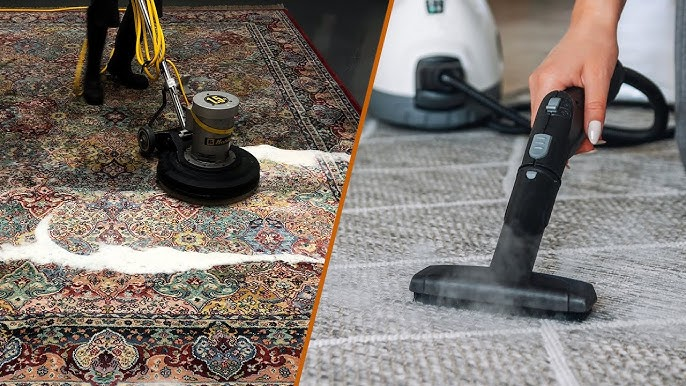Steam Carpet Cleaners vs. Traditional Methods: Which is Best for Deep Cleaning?

Cleaning carpets goes beyond mere aesthetics; it helps maintain your home’s health and flooring longevity. Carpets accumulate dust, allergens, bacteria, and stains over time. This not only tarnishes their appearance but also deteriorates the indoor air quality. There are two main methods of deep cleaning carpets: steam cleaning and traditional methods. Both have their pros and cons, and ideal use cases. Knowing the pros and cons of these methods will make it easier for you to decide on the best method.
What is Steam Carpet Cleaning?
Steam cleaning carpets, or hot water extraction, is a cleaning method that applies hot water, often in combination with a cleaning solution, to carpet fibres. Steam carpet cleaning begins with the application of hot cleaning solutions under pressure. During cleaning, the heated solution dissolves the dirt, grease, or stains, while the pressure relieves congestion trapped within the carpet fibres. The soiled water, along with dirt, allergens, and cleaning agents, is extracted immediately using a vacuum. The method works best on carpets with heavy dirt accumulation, difficult stains, and allergens like dust mites because it works on a deeper level.
Advantages of Steam Carpet Cleaners
Steam cleaning has some clear advantages. For one, the steam not only softens soils but also disinfects most sorts of bacteria, mold spores, and dust mites. For this reason, steam cleaning is perfect for homes with allergy sufferers and pets. The extraction method used also takes away most of the cleaning solution, which means there is only a small amount left that can attract dirt. Steam cleaning revitalises the carpets and completely restores their texture by lifting flattened fibres. Furthermore, steam cleaning is appropriate for different types of carpets, both synthetic and natural fibres, assuming they are water-safe.
Disadvantages of Steam Carpet Cleaners
Steam cleaning has its shortcomings, one of the main ones being the drying period. Depending on the humidity and the amount of air circulating in the room, carpets can take anywhere between 6 to 24 hours to dry. If left damp for too long, carpets can also be at risk of mould and mildew growth. In addition, steam cleaning a carpet requires either professional equipment or a high-quality rental machine. For this reason, steam cleaning is often more expensive than more traditional methods. Lastly, it is not appropriate for some fragile or antique rugs, which can shrink or sustain damage from too much moisture.
Discussion of Traditional Methods of Cleaning Carpets
Shampooing, dry cleaning, and bonnet cleaning are all part of a traditional carpet cleaning solution. Carpet shampooing is the process of scrubbing a carpet with a rotary machine and vacuuming the dried residue. Dry cleaning is a quicker method of cleaning as it utilises dirt-absorbing powders with minimal moisture. Bonnet cleaning is good for quick cleanups as it uses a rotating pad to lift dirt off the top layers of a carpet. While these methods may sound outdated, they are still preferred due to their cost and time savings.
Benefits of Traditional Methods
Carpets are often ready to be walked on within a couple of hours, particularly for busy households and businesses. This is one, if not the only, benefit of traditional methods. Because of the less expensive equipment needed, professional services almost instantly become affordable. Dry cleaning is particularly useful for delicate carpets that are on the cheaper end. Traditional methods are useful for light cleaning in between deep cleaning sessions.
Limitations of Traditional Methods
The drawback of many traditional methods is that the cleaning process tends to only focus on the surface of the carpet. Because of this focus, dirt and allergens that are embedded in the carpet are not removed. Additionally, the use of detergent can leave residue that makes the carpet dirtier than it was before. These methods become insufficient in the long run for households that have pets, suffer from allergies, or have a large amount of foot traffic.
Determining the Best Methods for Cleaning the Carpet
In terms of true deep cleaning, steam carpet cleaners tend to work better than traditional methods. Surface cleaning methods have a tough time dealing with the hard-to-reach carpet contaminants, which is a strength of steam cleaning due to the heat, water pressure, and suction used. Because of this, steam cleaning is best for deep cleaning once or twice a year. Traditional methods are best used between steam cleans in order to refresh carpets to maintain the steam cleaning effect without the need to dry carpets. An example would be a house with pets that needs to be steam cleaned quarterly and dry cleaned once a month.
Conclusion
Both steam carpet cleaners and traditional carpet cleaning methods have their advantages and can be used in combination to maintain a clean and healthy home. Steam cleaning is best used for deep and restorative cleaning to remove the dirt, allergens, and bacteria from carpets deeply embedded within the carpet’s fibres. On the other hand, traditional methods offer convenience and speed, which makes them ideal for routine maintenance. Knowing the advantages and disadvantages or strengths and limitations of both methods will allow the user to utilize the most appropriate method that will remove dirt while extending the carpet’s durability lifespan, about the overall cleaning strategy used in the house.


